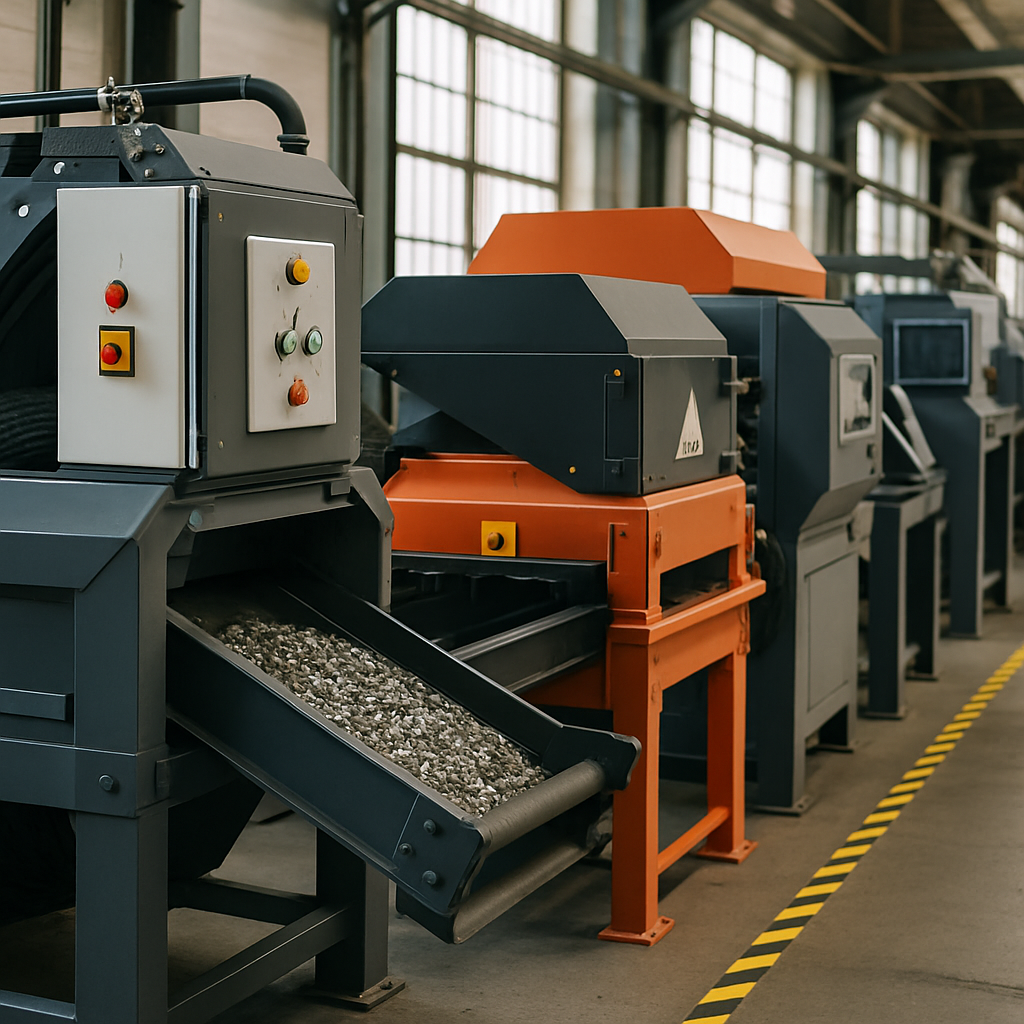5901 Botham Jean Blvd, Dallas, TX 75215
From Waste to Profit: A Guide to Metal Fines and Dust Recovery
November 7, 2025Every day, thousands of pounds of valuable metals end up as waste in landfills. These tiny metal particles, often invisible to the naked eye, represent both lost profits and environmental harm. The metal fines and dust recovery process provides an effective solution to this problem.
Metal fines and dust recovery is a specialized recycling technique that recovers valuable metal particles from waste materials that traditional recycling methods overlook. By using a combination of magnetic separation and eddy current technology, this process can extract both ferrous metals (containing iron) and non-ferrous metals (like aluminum and copper) from dust and fine particles as small as 0.2 mm.
The process begins by applying powerful magnetic fields to separate ferrous materials. Then, a rotating magnetic rotor generates eddy currents within the non-ferrous metals, causing them to be repelled from other materials. This separation occurs because the rapidly changing magnetic field induces electrical currents in the conductive metal particles, creating a repulsive force that pushes them away from non-metallic materials.
How Does the Recovery Process Work?

Metal recovery systems operate through a sequence of separation stages, each targeting specific metal types based on their unique physical properties. The process is efficient and methodical, much like a gold prospector using various techniques to extract gold from river sediment.
The first stage employs magnetic drums or pulleys to extract ferrous metals such as iron and steel. These magnets create a magnetic field that attracts ferrous materials from the mixed waste stream. The magnetic drums rotate continuously, pulling iron-based metals to a separate collection point while allowing non-magnetic materials to proceed through the system.
Once ferrous metals are removed, the remaining material advances to the second stage, where eddy current separators recover non-ferrous metals like aluminum, copper, and brass. These separators operate on an intriguing principle: a high-speed rotating magnetic rotor generates changing magnetic fields, inducing electric currents in conductive materials. These currents produce their own magnetic fields that repel the metals from the waste stream, akin to two magnets pushing against each other.
Advanced systems often integrate these separation technologies into a single, more efficient unit. For example, the STEINERT FinesMaster combines multiple separation stages: initially capturing strongly magnetic materials with a weak-field magnetic drum, using a powerful neodymium magnet to extract remaining ferrous impurities, and finally employing eddy current separation for non-ferrous metals.
This multi-stage approach enhances metal purity. Each separation phase further refines the material stream, similar to a coffee filter working through progressively finer layers. This results in highly purified metal streams that can directly re-enter manufacturing processes, reducing the need for virgin material extraction.
For extremely fine materials, specialized high-frequency eddy current separators can be used. These operate at speeds up to 4,000 RPM to create intense separation forces capable of recovering even the smallest metal particles, ensuring maximum resource recovery from waste streams.
What Are the Key Benefits of Metal Fines Recovery?
Metal fines recovery transforms what was once considered waste into valuable resources. This process offers numerous advantages for recycling operations while supporting broader environmental goals.
The financial benefits are immediate and substantial. Recycling facilities can create new revenue streams from materials previously sent to landfills. Recovery systems extract metals from fine particles that traditional processes miss, directly improving profitability.
Modern technologies like the RecoverMax Fines Process achieve impressive separation rates. These systems can achieve over 98% purity when isolating metals from other materials, maximizing the value of each ton processed.
Economic Advantages
The profitability improvements from metal fines recovery are notable. By processing materials once discarded as worthless, facilities can boost their bottom line without increasing incoming material volume. This represents pure profit from existing waste streams.
Metal fines contain valuable commodities, including copper, aluminum, and other non-ferrous metals. The market value for these recovered metals provides immediate financial returns on recovery investments. Many facilities report payback periods measured in months rather than years.
Lower disposal costs complement these revenue gains. Every ton of material recovered reduces landfill fees and transportation expenses. These savings add up quickly for high-volume recycling operations.
Environmental Benefits
Metal fines recovery significantly reduces waste volume. Materials that would otherwise fill landfill space are instead returned to the production cycle, aiding municipal goals for diversion and sustainability.
Resource conservation is another crucial benefit. The metals recovered through fines processing decrease the need for extracting virgin materials. This conservation helps preserve natural resources and reduces the environmental impact of mining operations.
Energy savings provide additional environmental advantages. Producing metals from recovered fines requires substantially less energy than processing virgin ore. For aluminum specifically, recycling uses just 5% of the energy needed for primary production.
The carbon footprint reduction is equally important. By decreasing energy consumption and landfill waste, metal fines recovery directly contributes to lowering greenhouse gas emissions. The EPA reports that metal recycling reduces emissions by approximately 29 million tons of carbon dioxide annually.
Technological Advantages
Advanced recovery systems offer exceptional precision in separating different metal types. This ensures that recovered materials meet industry specifications for reuse in manufacturing, with purity levels making these materials competitive with virgin resources.
The flexibility of modern systems allows for processing various input materials. Whether handling automobile shredder residue, electronic waste, or municipal solid waste, the technology can adapt to extract maximum value.
Compact equipment designs enable integration into existing recycling operations with minimal space requirements. This accessibility makes metal fines recovery practical for facilities of various sizes.
Implementing metal fines recovery supports compliance with increasingly stringent environmental regulations. As landfill restrictions tighten and resource recovery mandates expand, these systems help facilities stay ahead of regulatory requirements.
What Equipment is Used in Metal Fines Recovery?

Metal fines recovery requires specialized equipment designed to separate and capture valuable metals from mixed waste streams. These systems must handle small particles with precision and efficiency. Several key technologies have become industry standards for this specialized recovery process.
Magnetic Separation Systems
Magnetic separators form the foundation of metal fines recovery operations. These devices extract ferromagnetic materials from mixed waste streams using powerful magnetic fields. Two primary types are commonly used:
Magnetic drums consist of a stationary permanent magnet assembly enclosed within a rotating non-magnetic shell. As material passes over the drum, magnetic particles adhere to the surface and are carried away from the main flow. These systems are particularly effective for capturing fine iron particles with high purity rates.
Magnetic head pulleys function similarly but integrate directly into conveyor systems. The magnetic assembly is inside the head pulley of a conveyor belt, attracting ferrous materials as the material stream discharges. These pulleys are valued for their space-efficient design and ability to handle continuous flows with minimal interruption.
Eddy Current Separation Technology
For non-ferrous metals like aluminum, copper, and brass, eddy current separators are essential. These systems use a high-frequency magnetic field produced by a rapidly spinning rotor containing rare earth magnets. When non-ferrous metals pass through this field, they develop their own magnetic field that opposes the original, causing them to be ejected from the material stream.
Modern eddy current separators feature adjustable splitters and variable rotor speeds to optimize recovery rates for different material types and sizes. The latest models can process materials as small as 1-2 mm, making them crucial for fine metal recovery applications.
Integrated Fines Processing Systems
The STEINERT FinesMaster represents a significant advancement in metal fines recovery technology. This system combines multiple separation technologies into a single compact unit, eliminating the need for complex material transfer points between machines.
The FinesMaster incorporates a two-stage magnetic separation process. First, a weak-field magnetic drum extracts clean iron from the material flow. The residual fraction then passes to a fast-running magnetic separator equipped with strong neodymium permanent magnets, removing weakly magnetic impurities like ferrous dust and fluff, reducing downstream volume by up to 30%.
Finally, the material enters a high-frequency eddy current separator with an eccentric and adjustable pole system specifically designed for fine particles. This integrated approach delivers exceptional performance for materials between 1-25 mm, a range where traditional systems often struggle.
RecoverMax Fines Process System
The RecoverMax Fines Process offers another innovative approach to metal fines recovery. This patent-pending system is specifically designed to extract valuable metals from fine materials, recovering particles greater than 1 mm with remarkable precision.
At the heart of the RecoverMax is a specialized separator that effectively divides metals from non-metallic components like glass and rock with a purity exceeding 98%. The system then further refines the output, separating high-copper material into a concentrated fraction containing 90% or more copper and precious metals.
This multi-stage separation process creates refinery-grade material ready for direct sale, giving recyclers a significant market advantage. The RecoverMax system is engineered for consistent, high-throughput performance while requiring minimal maintenance, making it well-suited for demanding recycling environments.
Operational Benefits of Modern Recovery Systems
Today’s metal fines recovery equipment offers several key operational advantages over previous generations of technology:
- Enhanced recovery rates that capture metals as small as 1 mm, dramatically reducing valuable material loss
- Improved product purity, often exceeding 98%, which commands higher market prices
- Energy-efficient designs that minimize power consumption while maximizing throughput
- Reduced maintenance requirements through robust construction and fewer wear parts
- Flexible configurations tailored to specific material streams and space constraints
The continued evolution of these systems has transformed what was once considered low-value waste material into a profitable resource stream. By integrating magnetic separation, eddy current technology, and specialized fine particle processing, modern equipment provides recycling operations with powerful tools to extract maximum value from metal fines.
[[artifact_table]] Comparison of Leading Metal Fines Recovery Systems [[/artifact_table]]Conclusion: The Future of Metal Fines and Dust Recovery
As landfill costs rise and demand for recycled metals increases worldwide, metal fines and dust recovery processes have become vital components of modern recycling operations. Rapid advancements in this field now enable recovery systems to achieve significantly higher extraction rates, processing materials once considered waste.
This evolution in recovery technology signifies a critical shift in resource management within the recycling industry. For scrap yards and recycling facilities, investing in advanced metal fines recovery systems offers a clear path to increased profitability while simultaneously enhancing environmental performance. Capturing and processing these previously overlooked materials opens new revenue streams and reduces landfill waste.
For questions about implementing metal fines and dust recovery systems in your operations, contact Okon Recycling at 214-717-4083. Our team can help you evaluate the most effective solutions for your specific recycling needs.
